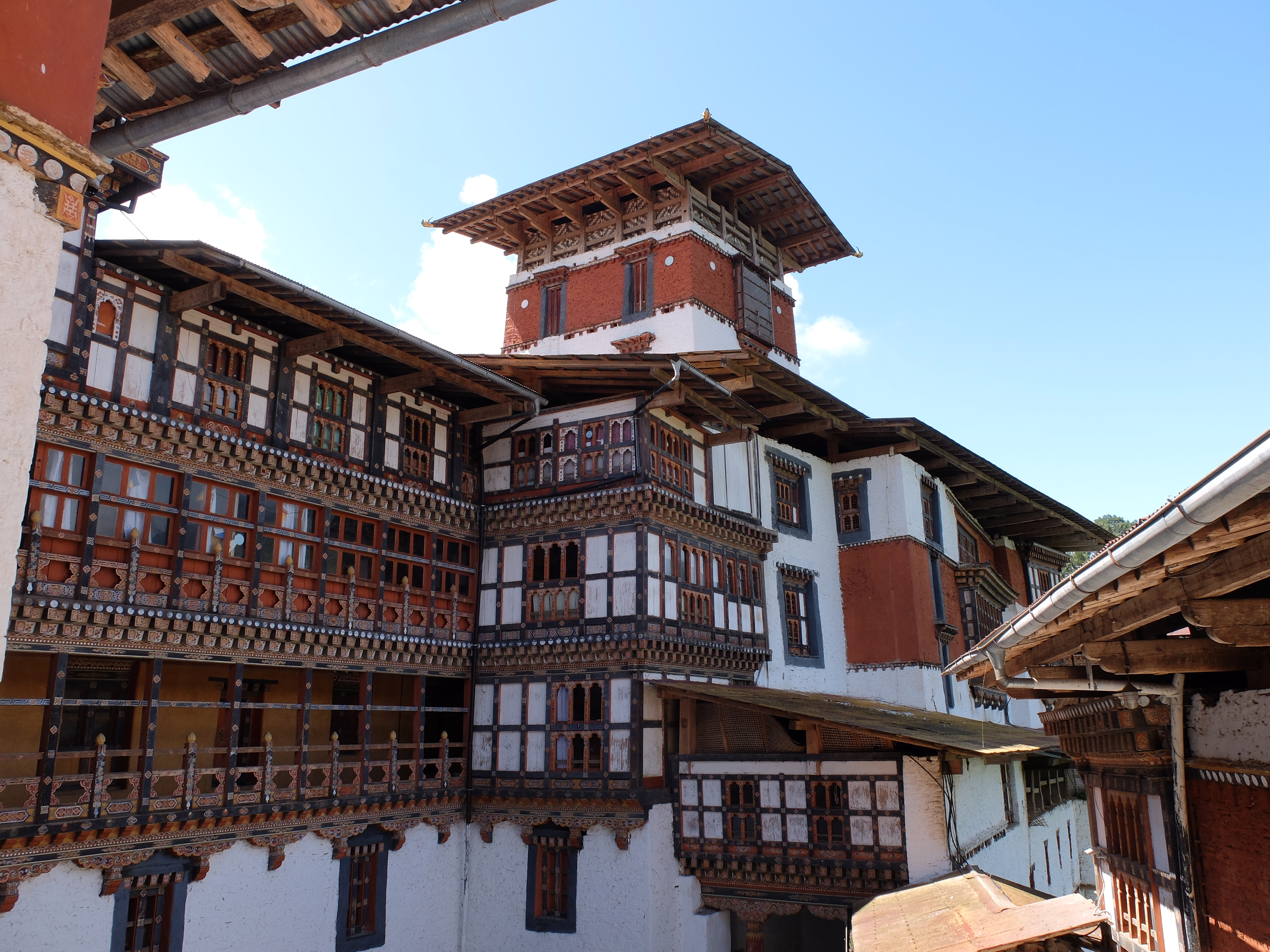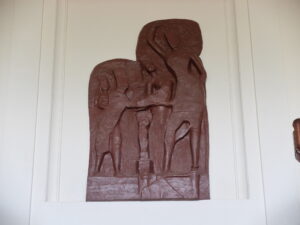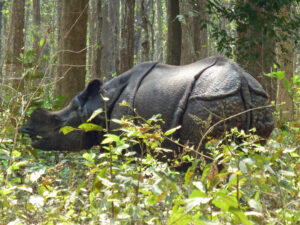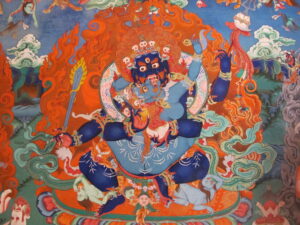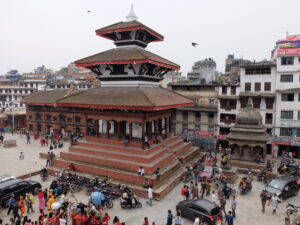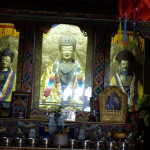
By 1616, Ngawanag Namgyal aka Zhabdrung, a revered leader originally from Tibet, unified the divided fiefdoms of Bhutan into a holy Buddhist empire. All over the country you see golden statues and images of Zhabdrung sporting a Chinese-style goatee. Around 800 years before he arrived, Buddhism had emerged from Tibet as well, peacefully unifying the religious beliefs of the people until this day.
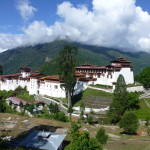
To consolidate as well as demonstrate his power, Zhabdrung built an array of 20 strategically placed holy fortresses, or dzongs.
Nineteen are still standing.
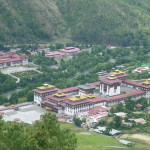
Their locations were, or became, provincial capitals. Some kept watch over passes from mountain tops, like the oldest dzong at Trongsa. Some protected riverways like the one at Punakha. Others controlled valleys like those at Thimphu and Paro.
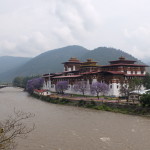
They seem to have worked, though perhaps the natural barriers – steep mountainous land and difficult passes – between Bhutan and its neighbors may have been just as important in keeping out potential invaders. Bhutan is considered one of the few countries never to have been conquered or subsumed by another.
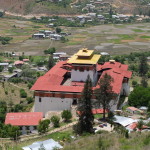
Instead, the Bhutanese fought themselves. Civil wars among the principalities kept things turbulent for nearly 300 years after Zhabdrung. Finally, with the help of the British colonial leaders that controlled India, the first king of the modern monarchy unified the country once again.
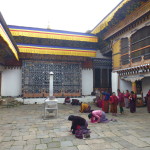
Before Zhabdrung, local rulers built forts to protect themselves and their people. They built temples to ensure divine protection. Among the oldest buildings still standing are some of the 108 holy temples built to quell evil demons in the 7th century by Songtsan Gampo across Tibet, Bhutan and Nepal.
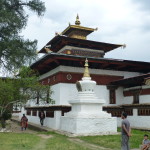
The divided and often warring princes added a number of forts during the next 800 years. Some of these have also survived, smaller than the later dzongs and often characterized by large circular watchtowers.

Zhabdrung, however, unified the secular, bureaucratic and religious leadership through his solid fortresses. The dzongs – and the governmental leaders – were kept holy by the monasteries and temples housed in the hearts of the forts. To the common villager, the fort served as a physical refuge against threats, and as a religious center for festivals and holy ceremonies.
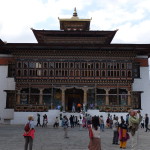
Even today the dzongs retain their dual nature: they house most government offices, except for those that can no longer fit in the dzong itself, and resident monks conduct the religious functions. Daily, people still come to the temples and prayer halls to offer their own prayers or be blessed by the monks. The large, stone block courtyards outside the prayer halls remain the primary gathering spots for festivals and major religious holidays.
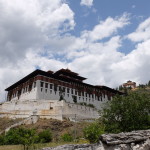
Though they all differ due to terrain, from the outside the dzongs are clearly fortresses, with towering walls of large stones laid together like bricks. On some, you can see the narrow slits used to fire arrows at any enemy or platforms to toss stones down.The walls are whitewashed, but near the top feature a red band usually adorned with circular golden emblems embossed with prayers. The whole structure is elongated to match the terrain, an irregular oblong.
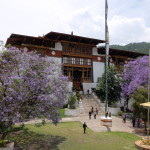
You typically enter by gateways perched over a tall staircase of narrow steps, then meander through passageways and courtyards of various sizes that connect buildings for government use, until you reach the inner sanctum of temples and monastery. The largest of the courtyards is usually adjacent to the temple where people gather for festival activity.
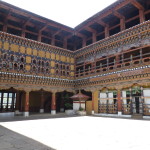
Each building is topped with a multi-tiered roof to admit light and circulate air. The tiers consist of two or four flat panels angled slightly downward, like the top of a pagoda but without winged edges. Capping the peaks are pointed golden cones.
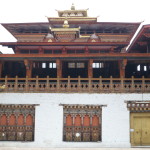
It’s the colorful, wood-trimmed look of those buildings within the dzong that soon dominated the building style in Bhutan, from palaces to farmhouses. It makes the man-made part of Bhutan as harmonious as the natural landscape and as any building style we’ve seen in alpine Europe. All the buildings are richly decorated with, to our eyes, stylistic ties to Tibet and China.
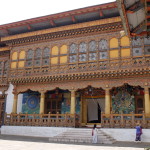
Below the roof, you’ll find three or four bands of dentils jutting out from the wall, each painted with geometric or floral designs. Below, sometimes thrusting out from the white stone walls, and sometimes set in, the windows are all framed in dark wood, painted with a similar variety of designs as well.

The placement of windows in the tallest buildings, such as the main prayer hall, makes the whole structure look upside-down: there are few, narrow windows at the lowest level and many, wider and more elaborately decorated ones below the eave. We think this helped light the building from the top where the most important rooms were. The windows are rectangular, but often have a scalloped arch at the top. Geometric grillwork covers many of them.
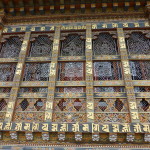
Some buildings have a continuous band of ornate windows around the top and covered verandahs or walkways. These buildings feature the most riotous display of color, painted on flat wood or on sculpted pieces set in relief – a wide range of swirls and curves, figures and emblems, running up and down the walls.
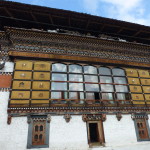
Local houses out in the villages often seem as intensely decorated as these. Most have the toothed band around the top and painted window frames. Many have sculpted pieces and intricate designs on the walls, as well as large painted figures over the plastered sections. None of this is pre-fabricated; every house – and every dentil under the eaves – is hand painted on site.
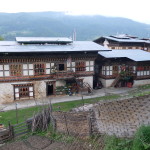
In some dzongs that preceded Zhabdrung, buildings evoke Tudor England’s half-timbered look, with white panels defined by dark wood cross members and simpler decoration. Many farmhouses we saw copy that look as well.
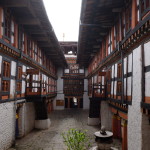
In their stylistic leadership, in their historical importance and in their ongoing function within Bhutan, it’s no wonder that the dzong has long been central to the culture. The word itself has great power as well. A region or administrative district is a dzonghag, a place with a fortress; the regional head, a dzongza.

More importantly, the language of the Bhutanese – quite distinct from Nepali or Chinese – is called dzongkha.
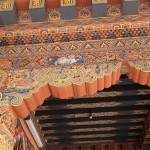
In the dzongs or in local houses, geometric and sinuous patterns occupy much of the painted wood surface, but certain mythological figures recur like the demonic head chasing away evil spirits or a flying garuda.
And then there’s the druk, the thunder dragon that symbolizes the country as much as the dzongs do. In carved wood attached to buildings inside or out, in painted panels on vertical wood pieces, as adornment for other key spots as if invoking a protective spirit – or in the handicraft shops for souvenir buyers – the s-shaped dragon is everywhere.
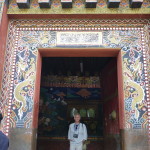
The dragon was in the old name of the country – Drukyul, or the land of the thunder dragon. That name seems to have come from Tibetans, perhaps when Buddhism arrived. They considered this a place of thunderstorms, which superstitious villagers still think of as the dragon’s work. It’s also likely that ridges of the wavy hills looming through mists or thunder clouds seemed to take on a druk-like form. They still do.

The civil leadership of the country since Zhabdrung and up to 1907 was put in the hands of a Druk Desi, Dragon Ruler. The form of Buddhism practiced in Bhutan is called Drukpa Kagyu, the Dragon School also out of Tibet, with the reincarnations of the Buddhist saints named Drukpa as well. The first modern king was called the Druk Gyalpo, the Dragon King. The flag of the country displays the druk in white on a split orange and yellow background, symbolic of the joint secular and religious leadership.
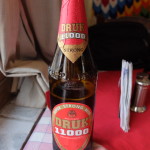
Of the two national airlines, one is Royal Bhutan; the other is Druk Air with the dragon painted on its tail. The main brewery in the country makes Druk beer, as a lager, as a premium Blue favored by Indians, and as our favorite Druk 11000, a malted ale with up to 8% of alcohol strong. The druk is Bhutan.
The British seemed to have interfered with naming, however, around the time they backed the first king. To them, Bhutan was a botanical treasure and fertile place for growing valuable things, like prized herbs: the word botanical turned into Bhutan. After over a 100 years, the new name has stuck. But older villagers apparently will still refer to their country as Drukyul.
The stolid dzong and the sinuous druk may epitomize Bhutanese culture, but the country has adopted some unusual state animals to represent it. The noisy, unattractive, unlovable but omnipresent raven is the national bird.
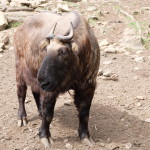
And it’s elevated a particularly odd beast as the national animal, the Takin. According to legend, a monk found shelter with a farming family that fed him an unfamiliar combination of goat and cow meat. He liked it so much that he prayed and meditated for its like in the future. His prayers were rewarded as he somehow found a way to breed the takin out of the two mismatched species.
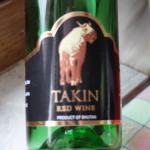
The takin is no beauty. As per legend, it’s a bit like an over-sized goat in back with a small, horned bull-like head in front. In reality, the takin is a natural species of goat antelope, a wild animal unable to be domesticated and whose Bhutanese version is endangered.
The lowly raven is honored by the “Raven crown” that the kings wear in ceremonies. By contrast, the takin – not legendary enough to adorn the dzongs and way too earthbound to replace the druk – has but one place of dubious honor…on the label of a barely drinkable Bhutanese wine.
(Also, for more pictures from Nepal, Tibet and Bhutan, CLICK HERE to view the slideshow at the end of the Nepal-Tibet-Bhutan itinerary page.)


